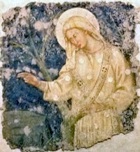

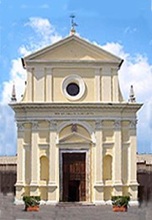
A community of Servite friars under Prior Ristoro da Firenze was established at outside Orvieto in 1259, soon after the formation of their order. Bishop Giacomo gave them the church of San Pietro in Vetere in Campo della Fiera in 1260. They bought land on the present site, near the church of Santa Lucia, which was then in the parish of San Martino, in 1265. This brought them into conflict with the monks of the Abbazia di SS Severo e Martirio, who had rights over the parish. Pope Clement IV intervened to settle the dispute in their favour and granted indulgences in 1268 to facilitate the construction of the church and convent. The church was completed by ca. 1290.
The friars abandoned the convent in 1830, when a wall of the church and its roof collapsed. It was left in ruins until 1855, when the Provincial Chapter (meeting in Perugia) decided to rebuild it. In 1857, Virginio Vespignani was commissioned to design the new church in the neoclassical style, no doubt at the suggestion of his brother, Bishop Giuseppe Maria Vespignani. Work was halted by the civil unrest of 1860, and the complex passed to the civic authorities. At this point, the facade remained unbuilt.
The complex was used as a barracks until 1870, when it was put up for sale. The structure was then undermined by an earthquake in 1873. A priest called Padre Francesco Riscossa bought it at auction later that year, and restored it with financial help from Giuseppe Bracci. The completed church, which served the surrounding parish, was consecrated in 1875.
The church, which was closed for repair after the earthquake of 1997, reopened to the public on Christmas Eve, 1998.
Exterior
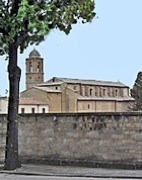
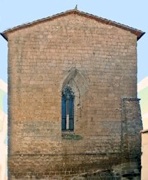
The original apse of the church survives, together with a bifore window. This original structure can be seen from the rear of the complex, with the new campanile (1860) to the left of it.
The neo-classical facade is illustrated above. A portico present in the original design for it was never built. The terracotta statues that were originally in the niches to the sides of the portal no longer survive.
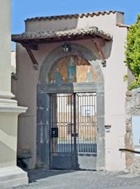
Interior
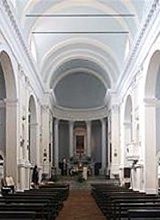
The interior has a nave and two narrow aisles, each of which contains three interconnected side chapels. A curved arcade delineates the new choir. It was built in front of its Gothic predecessor, which now serves as a sacristy and is reached from doors to the sides.
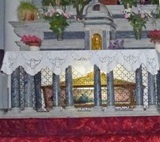
The relics of the Blessed Thomas of Orvieto are preserved under the high altar.
The organ on the counter-facade is supported by a colonnade of two columns and two pilasters.
Water stoup (1497)
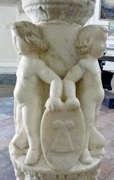
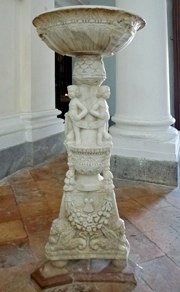
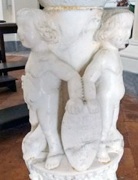
This holy water stoup is on the right, near the entrance.
-
✴One pair of putti carries an inscription that records its commission in 1497 by Benedetto Crespa, the castellan of the Rocca del Albornoz.
-
✴Two other pairs of putti carry (respectively):
-
•the arms of Pope Alexander VI; and
-
•those of his son, Cesare Borgia.
The work is often attributed to Antonio Federighi, but he died in 1483.
Madonna and Child (15th century)
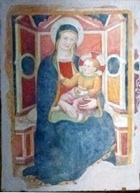
Blessed Thomas of Orvieto (15th century)
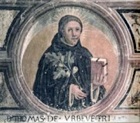
Cappella del Crocifisso
This chapel to the right of the entrance belonged to the Compagnia dei Disciplinati di Gesù Cristo. [History ??]
Crucifix (14th century)
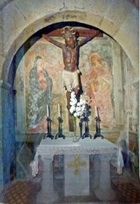
Other Frescoes (15th century)
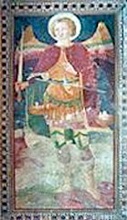
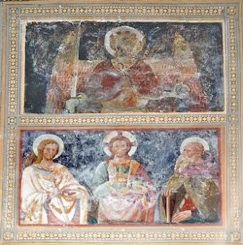
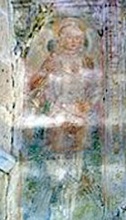
St Michael St Michael (above) St George
Christ blessing with SS James and Antony Abbot
(left wall) (back wall) (right wall)
These damaged frescoes are attributed to Pietro di Nicola Baroni. The inscription on the fresco of Christ with saints states that He rules "Asya, Africa, Europa".
Sacristy
[Crucifixion (15th century)
This fresco in the sacristy is attributed to Pietro di Nicola Baroni.]
Art Removed from the Church
Madonna and Child Enthroned (ca. 1270)
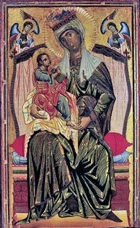
The altarpiece was moved to the counter-facade at some point (probably in the 1320s to make way for what is now called the Gardner Polyptych - see below). However, it was translated back to the high altar in 1733 after a miracle in which the Madonna was seen to weep tears of blood. It was documented on the high altar of the new church in 1861, at which point the Madonna and Child each wore a golden crown that had been affixed as a votive offering and the altarpiece was covered by another painting (presumably for protection). The panel, which has been slightly spoiled by repainting and is cropped at the bottom, was restored in 1927-8.
The altarpiece was stolen in 1953 and the thieves tried to sell it to the National Gallery, London. The authorities were alerted and the altarpiece was recovered. It was restored again in 1965-70, when some of the repainting was removed. The traditional attribution to Coppo di Marcovaldo was reinforced at this point, although not to the satisfaction of all scholars. The altarpiece finally found way back to Orvieto in 1984 and was returned to Santa Maria dei Servi. It was subsequently moved to the Museo dell' Opera del Duomo for security reasons.
Gardner Polyptych (1320s)
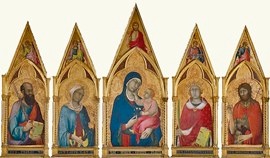
These five panels in the Isabella Stewart Gardner Museum, Boston, Massachusetts, which are attributed to Simone Martini, were first documented in 1671, when they were in the sacristy. They probably came from a polyptych that was installed on the high altar.
These surviving panels depict:
-
✴the Madonna and Child with Christ the Redeemer above;
-
✴St Paul;
-
✴St Lucy;
-
✴St Catherine of Alexandria; and
-
✴St John the Baptist.
Each panel has a musical angel above carrying an instrument of the Passion. These were probably the only main panels of the polyptych, but it almost certainly also had predella panels that have been lost.
The later history of the surviving panels was described in a series of letters that were discovered in Rome in the 1980s. The Servites seem to have sold them in ca. 1842 to two Chilean diplomats, probably to raise money following the collapse of their church. The sale came to light when the Chileans attempted to export the panels, and the Roman authorities insisted that it should be returned to Santa Maria dei Servi. In 1851, the friars finally received permission to sell them to Leandro Mazzocchi on the condition that they should be installed in his private chapel in Orvieto. In fact, the Mazzocchi family lent them to the Museo dell' Opera del Duomo and then sold them to the Isabella Stewart Gardner Museum in 1899.
Madonna dell’ Olivo (early 15th century)
